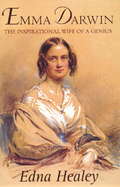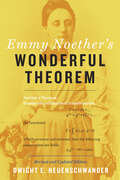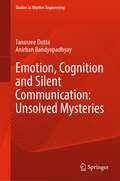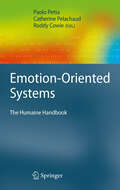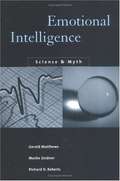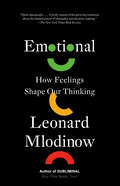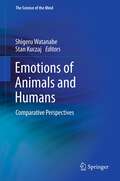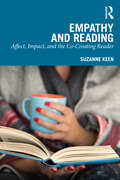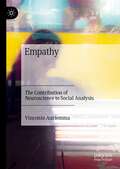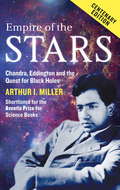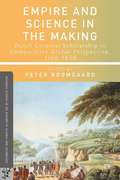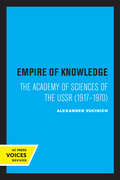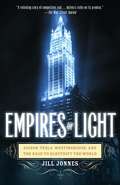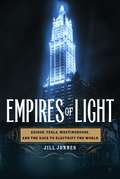- Table View
- List View
Emma Darwin: The Wife of an Inspirational Genius
by Edna HealeyMuch has been written about Charles Darwin but this is the first biography of his strong, intelligent wife. Emma Wedgwood, granddaughter of the famous Josiah, married Charles Darwin in 1839, three years after he returned from his extraordinary voyage on the Beagle. Their life together was intellectually exciting though overshadowed by personal tragedy. Edna Healey has discovered new, and hitherto unpublished, material and has had the full support of the Darwin family in writing this major biography.
Emmy Noether's Wonderful Theorem
by Dwight E. NeuenschwanderOne of the most important—and beautiful—mathematical solutions ever devised, Noether’s theorem touches on every aspect of physics."In the judgment of the most competent living mathematicians, Fräulein Noether was the most significant creative mathematical genius thus far produced since the higher education of women began."—Albert EinsteinThe year was 1915, and the young mathematician Emmy Noether had just settled into Göttingen University when Albert Einstein visited to lecture on his nearly finished general theory of relativity. Two leading mathematicians of the day, David Hilbert and Felix Klein, dug into the new theory with gusto, but had difficulty reconciling it with what was known about the conservation of energy. Knowing of her expertise in invariance theory, they requested Noether’s help. To solve the problem, she developed a novel theorem, applicable across all of physics, which relates conservation laws to continuous symmetries—one of the most important pieces of mathematical reasoning ever developed.Noether’s "first" and "second" theorem was published in 1918. The first theorem relates symmetries under global spacetime transformations to the conservation of energy and momentum, and symmetry under global gauge transformations to charge conservation. In continuum mechanics and field theories, these conservation laws are expressed as equations of continuity. The second theorem, an extension of the first, allows transformations with local gauge invariance, and the equations of continuity acquire the covariant derivative characteristic of coupled matter-field systems. General relativity, it turns out, exhibits local gauge invariance. Noether’s theorem also laid the foundation for later generations to apply local gauge invariance to theories of elementary particle interactions. In Dwight E. Neuenschwander’s new edition of Emmy Noether’s Wonderful Theorem, readers will encounter an updated explanation of Noether’s "first" theorem. The discussion of local gauge invariance has been expanded into a detailed presentation of the motivation, proof, and applications of the "second" theorem, including Noether’s resolution of concerns about general relativity. Other refinements in the new edition include an enlarged biography of Emmy Noether’s life and work, parallels drawn between the present approach and Noether’s original 1918 paper, and a summary of the logic behind Noether’s theorem.
Emotion and the Contemporary Museum: Development of a Geographically-Informed Approach to Visitor Evaluation
by Candice P. Boyd Rachel HughesThis book outlines a geographically-informed method of evaluating the emotional impact of museum exhibits. The authors have personally developed the method they describe over several years of working with the Museo Laboratorio della Mente in Rome and the Melbourne Museum in Australia. Informed by non-representational theories in cultural geography, this book offers solutions to museum staff for how they might evaluate aspects of visitor experience, such as emotions and embodied experience, which can be very difficult to assess using conventional approaches.
Emotion in the Mind and Body (Nebraska Symposium on Motivation #66)
by Maital Neta Ingrid J. HaasAs the 66th volume in the prestigious Nebraska Series on Motivation, this book focuses on understanding emotion and motivation as two factors that not only influence social and cognitive processes, but also shape the way we navigate our social world. Research on emotion has increased significantly over the past two decades, pulling from scholarship in psychology, neuroscience, medicine, political science, sociology, and even computer science. This volume is informed by the growing momentum in the resulting interdisciplinary field of affective science, and examines the role of emotion and motivation in our perceptions, decision-making, and social interactions, and attempts to understand the neurobiological mechanisms that support these processes across the lifespan in both healthy and clinical populations. Included among the chapters: Emotion concept development from childhood to adulthoodEvolving psychological and neural models for the regulation of emotionPathways to motivational impairments in psychopathologyA valuation systems perspective on motivationReproducible, generalizable brain models of affective processes Emotion in the Mind and Body is a comprehensive and compelling rendering of the current state of the interdisciplinary field of affective science, and will be of interest to researchers and students working in psychology and neuroscience, as well as medicine, political science, and sociology.
Emotion, Cognition and Silent Communication: Unsolved Mysteries (Studies in Rhythm Engineering)
by Anirban Bandyopadhyay Tanusree DuttaThis book provides an answer to the readers about scientific perspective on learning. It presents a culminating point of four different kinds of studies designed to measure and understand the nuances of brain functioning. The objective of this book is to find answers to four questions: (1) can there be a neuroscientific understanding of the concept of individual differences? (2) does rhythmic sound or noise have an impact on decision making? (3) how does transfer of learning between the hemispheres facilitate the learning process? and lastly (4) beyond the accepted ways of communicating verbally and non-verbally is silent communication possible? This book makes an attempt to address these issues through various aspects of inner-conscious engineering.
Emotion-Oriented Systems
by Catherine Pelachaud Paolo Petta Roddy CowieEmotion pervades human life in general, and human communication in particular, and this sets information technology a challenge. Traditionally, IT has focused on allowing people to accomplish practical tasks efficiently, setting emotion to one side. That was acceptable when technology was a small part of life, but as technology and life become increasingly interwoven we can no longer ask people to suspend their emotional nature and habits when they interact with technology. The European Commission funded a series of related research projects on emotion and computing, culminating in the HUMAINE project which brought together leading academic researchers from the many related disciplines. This book grew out of that project, and its chapters are arranged according to its working areas: theories and models; signals to signs; data and databases; emotion in interaction; emotion in cognition and action; persuasion and communication; usability; and ethics and good practice. The fundamental aim of the book is to offer researchers an overview of the related areas, sufficient for them to do credible work on affective or emotion-oriented computing. The book serves as an academically sound introduction to the range of disciplines involved - technical, empirical and conceptual - and will be of value to researchers in the areas of artificial intelligence, psychology, cognition and user--machine interaction.
Emotional Intelligence: Science and Myth
by Gerald Matthews Moshe Zeidner Richard D. RobertsEmotional intelligence (EI) is one of the most widely discussed topics in current psychology. Although first mentioned in the professional literature nearly two decades ago, in the past five years it has received extensive media attention.
Emotional: How Feelings Shape Our Thinking
by Leonard MlodinowWe&’ve all been told that thinking rationally is the key to success. But at the cutting edge of science, researchers are discovering that feeling is every bit as important as thinking in this "lively exposé of the growing consensus about the limited power of rationality and decision-making" (The New York Times Book Review).You make hundreds of decisions every day, from what to eat for breakfast to how you should invest, and not one of those decisions would be possible without emotion. It has long been said that thinking and feeling are separate and opposing forces in our behavior. But as Leonard Mlodinow, the best-selling author of Subliminal, tells us, extraordinary advances in psychology and neuroscience have proven that emotions are as critical to our well-being as thinking. How can you connect better with others? How can you make sense of your frustration, fear, and anxiety? What can you do to live a happier life? The answers lie in understanding your emotions. Journeying from the labs of pioneering scientists to real-world scenarios that have flirted with disaster, Mlodinow shows us how our emotions can help, why they sometimes hurt, and what we can learn in both instances. Using deep insights into our evolution and biology, Mlodinow gives us the tools to understand our emotions better and to maximize their benefits. Told with his characteristic clarity and fascinating stories, Emotional explores the new science of feelings and offers us an essential guide to making the most of one of nature&’s greatest gifts.
Emotions of Animals and Humans
by Shigeru Watanabe Stan KuczajThis book takes a multidisciplinary approach to emotion, with contributions from biologists, psychologists, neuroscientists, robot engineers, and artists. A wide range of emotional phenomena is discussed, including the notion that humans' sophisticated sensibility, as evidenced by our aesthetic appreciation of the arts, is based at least in part on a basic emotional sensibility that is found in young children and perhaps even some non-human animal species. As a result, this book comprises a unique comparative perspective on the study of emotion. A number of chapters consider emotions in a variety of animal groups, including fish, birds, and mammals. Other chapters expand the scope of the book to humans and robots. Specific topics covered in these chapters run the gamut from lower-level emotional activity, such as emotional expression, to higher-level emotional activity, such as altruism, love, and aesthetics. Taken as a whole, the book presents manifold perspectives on emotion and provides a solid foundation for future multidisciplinary research on the nature of emotions.
Empathy Imperiled
by Gary OlsonThe most critical factor explaining the disjuncture between empathy's revolutionary potential and today's empathically-impaired society is the interaction between the brain and our dominant political culture. The evolutionary process has given rise to a hard-wired neural system in the primal brain and particularly in the human brain. This book argues that the crucial missing piece in this conversation is the failure to identify and explain the dynamic relationship between an empathy gap and the hegemonic influence of neoliberal capitalism, through the analysis of the college classroom, the neoliberal state, media, film and photo images, marketing of products, militarization, mass culture and government policy. This book will contribute to an empirically grounded dissent from capitalism's narrative about human nature. Empathy is putting oneself in another's emotional and cognitive shoes and then acting in a deliberate, appropriate manner. Perhaps counter-intuitively, it requires self-empathy because we're all products of an empathy-anesthetizing culture. The approach in this book affirms a scientific basis for acting with empathy, and it addresses how this can help inform us to our current political culture and process, and make its of interest to students and scholars in political science, psychology, and other social sciences.
Empathy and Reading: Affect, Impact, and the Co-Creating Reader
by Suzanne KeenThis pioneering collection brings together Suzanne Keen’s extensive body of work on empathy and reading, charting the development of narrative empathy as an area of inquiry in its own right and extending cross-disciplinary conversations about empathy evoked by reading. The volume offers a brief overview of the trajectory of research following the 2007 publication of Empathy and the Novel, with empathy understood as a suite of related phenomena as stimulated by representations in narratives. The book is organized around three thematic sections—theories; empathetic readers; and interdisciplinary applications—each preceded by a short framing essay. The volume features excerpts from the author’s seminal works on narrative empathy and makes available her harder-to-access contributions. The book brings different strands of the author’s research into conversation with existing debates, with the aim of inspiring future interdisciplinary research on narrative empathy. This book will be of interest to students and scholars in such fields as literary studies, cognitive science, emotion studies, affect studies, and applied contexts where empathetic practitioners work.
Empathy and Reading: Affect, Impact, and the Co-Creating Reader
by Suzanne KeenThis pioneering collection brings together Suzanne Keen’s extensive body of work on empathy and reading, charting the development of narrative empathy as an area of inquiry in its own right and extending cross-disciplinary conversations about empathy evoked by reading. The volume offers a brief overview of the trajectory of research following the 2007 publication of Empathy and the Novel, with empathy understood as a suite of related phenomena as stimulated by representations in narratives. The book is organized around three thematic sections—theories; empathetic readers; and interdisciplinary applications—each preceded by a short framing essay. The volume features excerpts from the author’s seminal works on narrative empathy and makes available her harder-to-access contributions. The book brings different strands of the author’s research into conversation with existing debates, with the aim of inspiring future interdisciplinary research on narrative empathy. This book will be of interest to students and scholars in such fields as literary studies, cognitive science, emotion studies, affect studies, and applied contexts where empathetic practitioners work.
Empathy: The Contribution of Neuroscience to Social Analysis
by Vincenzo AuriemmaThis book examines the concept of empathy in sociological and neuroscientific discourses using innovative perspectives from sociology and social neuroscience. Through a transdisciplinary approach, the author delves into the history of empathy and its social, cultural and semantic changes, and then reviews the conception of empathy in neuroscientific discourse.Distancing itself from the traditional neuroscientific literature of biological universalism, this volume offers an innovative perspective on empathy. It also opens a new avenue for neurosociology, which is presented as the discipline that can emphasize all the cultural and emotional aspects that govern empathy. Key themes addressed in the text are: empathy in all its meanings, from Hume to TenHouten; neurosociology as one possible avenue for embracing the cultural and neuroscientific aspects of empathy; and empirical research. A valuable resource for sociology students and academics in the field of empathy and neurosociology, this book is also of interest to those studying sociological thought, and social neuroscience.
Emperor Penguin (A Day in the Life: Polar Animals)
by Katie MarsicoFrom sun up to sundown, this nonfiction book takes young nature explorers and zoologists through a day in the life of the emperor penguin. Discover their Antarctic home, eating habits, and fascinating behaviors. Plus, kids can continue exploring after the penguins go to sleep! A step-by-step life cycle diagram, critical-thinking questions, and further resources will keep fact-hungry kids learning about the emperor penguin.
Emperors of the Deep: Sharks—The Ocean's Most Mysterious, Most Misunderstood, and Most Important Guardians
by William McKeeverWhat we can learn from sharks—evolutionary marvels that have survived for 450 million years, and are essential to our planet’s ecosystem.We’re conditioned to see sharks as terrifying, cold-blooded underwater predators. But as Ocean Guardian founder William McKeever reveals, we need to ensure that their remarkable longevity continues. The first book to reveal in full the hidden lives of sharks, Emperors of the Deep focuses on four species—Mako, Tiger, Hammerhead, and Great White—as never before, including such fascinating details as:Sharks are 50 million years older than treesSharks have survived five extinction level events, including the one that killed off the dinosaursSharks have electroreception, a sixth sense that lets them pick up on electric fields generated by living thingsSharks can dive 4,000 feet below the surfaceSharks account for only six human fatalities per year, while humans kill 100 million sharks per yearMcKeever goes back through time to probe the shark’s prehistoric secrets and how it has become the world’s most feared, and most misunderstood, predator, and takes us on a pulse-pounding tour around the world and deep under the surface, from the frigid waters of the Arctic Circle to the coral reefs of the tropical Central Pacific. He also interviews ecologists, conservationists, and world-renowned shark experts, including the founders of Greenpeace’s Rainbow Warrior, the head of the Massachusetts Shark Research Program, and the self-professed “last great shark hunter.”At once a deep dive into the misunderstood world of sharks and an urgent call to protect them, Emperors of the Deep celebrates this wild species that hold the key to unlocking the mysteries of the ocean—if we can prevent their extinction from climate change and human hunters.“Many astonishing facts.” —The Guardian“[An] extraordinary book [that] rarely fails to inform and delight.” —The Washington TimesIncludes photographs
Empire Of The Stars: Friendship, Obsession and Betrayal in the Quest for Black Holes
by Arthur I. MillerIn August 1930, on a boat trip from Bombay to England, the young Indian scientist Subrahmanyan Chandrasekhar calculated that certain stars could end their lives by collapsing indefinitely to a point - to nowhere. This idea brought Chandra into conflict with Sir Arthur Eddington, the grand old man of British astrophysics, who publicly ridiculed the idea.EMPIRE OF THE STARS teases out the major implications of this infamous event, setting it against the backdrop of the turbulent growth of astrophysics, and provides a unique window on our unfolding view of the cosmos. In its clash of personalities, epochs and cultures, the story reveals the deep-seated psychological and philosophical prejudices at work in the acceptance and rejection of new scientific ideas.Beautifully written, artfully constructed, EMPIRE OF THE STARS is a serious book but one which also deals with classic themes -- a lone man struggling against the establishment, intellectual rivalry and the highs and lows of great individuals set against the broader sweep of history.
Empire Of The Stars: Friendship, Obsession and Betrayal in the Quest for Black Holes
by Arthur I. MillerIn August 1930, on a boat trip from Bombay to England, the young Indian scientist Subrahmanyan Chandrasekhar calculated that certain stars could end their lives by collapsing indefinitely to a point - to nowhere. This idea brought Chandra into conflict with Sir Arthur Eddington, the grand old man of British astrophysics, who publicly ridiculed the idea.EMPIRE OF THE STARS teases out the major implications of this infamous event, setting it against the backdrop of the turbulent growth of astrophysics, and provides a unique window on our unfolding view of the cosmos. In its clash of personalities, epochs and cultures, the story reveals the deep-seated psychological and philosophical prejudices at work in the acceptance and rejection of new scientific ideas.Beautifully written, artfully constructed, EMPIRE OF THE STARS is a serious book but one which also deals with classic themes -- a lone man struggling against the establishment, intellectual rivalry and the highs and lows of great individuals set against the broader sweep of history.
Empire and Science in the Making
by Peter BoomgaardDrawing on extensive new research, and bringing much new scholarship before English readers for the first time, this wide-ranging volume examines how knowledge was created and circulated throughout the Dutch Empire, and how these processes compared with those of the Imperial Britain, Spain, and Russia.
Empire of Knowledge: The Academy of Sciences of the USSR 1917 - 1970
by Alexander VucinichThis title is part of UC Press's Voices Revived program, which commemorates University of California Press’s mission to seek out and cultivate the brightest minds and give them voice, reach, and impact. Drawing on a backlist dating to 1893, Voices Revived makes high-quality, peer-reviewed scholarship accessible once again using print-on-demand technology. This title was originally published in 1984.
Empire of the Air
by Jenifer Van VleckJenifer Van Vleck's fascinating history reveals the central role commercial aviation played in the United States' ascent to global preeminence in the twentieth century. As U. S. military and economic influence grew, the federal government partnered with the aviation industry to deliver American power across the globe and to sell the idea of the "American Century" to the public at home and abroad. The airplane promised to extend the frontiers of the United States "to infinity," as Pan American World Airways president Juan Trippe said. As it accelerated the global circulation of U. S. capital, consumer goods, technologies, weapons, popular culture, and expertise, few places remained distant from Wall Street and Washington. Aviation promised to secure a new type of empire--an empire of the air instead of the land, which emphasized access to markets rather than the conquest of territory and made the entire world America's sphere of influence. By the late 1960s, however, foreign airlines and governments were challenging America's control of global airways, and the domestic aviation industry hit turbulent times. Just as the history of commercial aviation helps to explain the ascendance of American power, its subsequent challenges reflect the limits and contradictions of the American Century.
Empire of the Air: The Men Who Made Radio
by Tom LewisEmpire of the Air is a history of radio in the United States. It tells the almost-unknown story of three American visionaries--scientist Lee de Forest, brilliant recluse Edwin H. Armstrong, and RCA mogul David Sarnoff--whose imagination and dreams turned a hobbyists' toy into radio, launching the modern communication age. It is a tale of pioneers on the frontier of a new technology, of American entrepreneurial spirit, and of the tragic collision between the lone inventor and the large corporation. Court cases would decide whose legacy would reign supreme. A magnificently researched biography of extraordinary men whose achievements changed our lives forever.
Empire of the Beetle
by Andrew NikiforukBeginning in the late 1980s, a series of improbable bark beetle outbreaks unsettled iconic forests and communities across western North America. An insect the size of a rice kernel eventually killed more than 30 billion pine and spruce trees from Alaska to New Mexico. Often appearing in masses larger than schools of killer whales, the beetles engineered one of the world's greatest forest die-offs since the deforestation of Europe by peasants between the eleventh and thirteenth centuries. The beetle didn't act alone. Misguided science, out-of-control logging, bad public policy, and a hundred years of fire suppression created a volatile geography that released the world's oldest forest manager from all natural constraints. Like most human empires, the beetles exploded wildly and then crashed, leaving in their wake grieving landowners, humbled scientists, hungry animals, and altered watersheds. Although climate change triggered this complex event, human arrogance assuredly set the table. With little warning, an ancient insect pointedly exposed the frailty of seemingly stable manmade landscapes.Drawing on first-hand accounts from entomologists, botanists, foresters, and rural residents, award-winning journalist Andrew Nikiforuk, investigates this unprecedented beetle plague, its startling implications, and the lessons it holds.
Empire, Nation-building, and the Age of Tropical Medicine, 1885–1960 (Medicine and Biomedical Sciences in Modern History)
by Mauro Capocci Daniele CozzoliThis book investigates the complex relationship between the development of modern empires, nation, and the history of tropical medicine. Broadening existing historiographical perspectives, it explores imperialism outside of the British Empire, drawing on case studies from other colonial experiences in Africa, Asia, and South America in the late-nineteenth and early-twentieth century. Each of these systems adopted different approaches to colonial health and medicine. By studying their diversity, it is possible to obtain a more comprehensive picture of what we now call ‘tropical medicine.’ The authors emphasise that the British model cannot be adapted to all colonial experiences, drawing on relevant cases from both interoceanic and continental empires. The collection comprises three sections. The first examines the role of tropical medicine in the evolution and collapse of empire in countries such as Portugal and the Netherlands. The second part analyses the links between tropical medical institutions and imperial commercial and political expansion in Britain and Brazil. Finally, the authors tackle the crucial interrelated circulation of people, objects, and ideas amongst countries including Brazil, China, Italy, and Spain. Using a medical lens to analyse the inter-connected processes of nation-building and colonial expansion in the late-nineteenth and early-twentieth centuries, this book provides valuable reading for scholars of imperialism and medical history alike.
Empires of Light: Edison, Tesla, Westinghouse, and the Race to Electrify the World
by Jill JonnesIn the final decades of the nineteenth century, three brilliant and visionary titans of America’s Gilded Age—Thomas Edison, Nikola Tesla, and George Westinghouse—battled bitterly as each vied to create a vast and powerful electrical empire. In Empires of Light, historian Jill Jonnes portrays this extraordinary trio and their riveting and ruthless world of cutting-edge science, invention, intrigue, money, death, and hard-eyed Wall Street millionaires. At the heart of the story are Thomas Alva Edison, the nation’s most famous and folksy inventor, creator of the incandescent light bulb and mastermind of the world’s first direct current electrical light networks; the Serbian wizard of invention Nikola Tesla, elegant, highly eccentric, a dreamer who revolutionized the generation and delivery of electricity; and the charismatic George Westinghouse, Pittsburgh inventor and tough corporate entrepreneur, an industrial idealist who in the era of gaslight imagined a world powered by cheap and plentiful electricity and worked heart and soul to create it. Edison struggled to introduce his radical new direct current (DC) technology into the hurly-burly of New York City as Tesla and Westinghouse challenged his dominance with their alternating current (AC), thus setting the stage for one of the eeriest feuds in American corporate history, the War of the Electric Currents. The battlegrounds: Wall Street, the 1893 Chicago World’s Fair, Niagara Falls, and, finally, the death chamber—Jonnes takes us on the tense walk down a prison hallway and into the sunlit room where William Kemmler, convicted ax murderer, became the first man to die in the electric chair. Empires of Light is the gripping history of electricity, the “mysterious fluid,” and how the fateful collision of Edison, Tesla, and Westinghouse left the world utterly transformed.
Empires of Light: Edison, Tesla, Westinghouse, and the Race to Electrify the World
by Jill JonnesIn the final decades of the nineteenth century, three brilliant and visionary titans of America’s Gilded Age—Thomas Edison, Nikola Tesla, and George Westinghouse—battled bitterly as each vied to create a vast and powerful electrical empire. InEmpires of Light, historian Jill Jonnes portrays this extraordinary trio and their riveting and ruthless world of cutting-edge science, invention, intrigue, money, death, and hard-eyed Wall Street millionaires. At the heart of the story are Thomas Alva Edison, the nation’s most famous and folksy inventor, creator of the incandescent light bulb and mastermind of the world’s first direct current electrical light networks; the Serbian wizard of invention Nikola Tesla, elegant, highly eccentric, a dreamer who revolutionized the generation and delivery of electricity; and the charismatic George Westinghouse, Pittsburgh inventor and tough corporate entrepreneur, an industrial idealist who in the era of gaslight imagined a world powered by cheap and plentiful electricity and worked heart and soul to create it. Edison struggled to introduce his radical new direct current (DC) technology into the hurly-burly of New York City as Tesla and Westinghouse challenged his dominance with their alternating current (AC), thus setting the stage for one of the eeriest feuds in American corporate history, the War of the Electric Currents. The battlegrounds: Wall Street, the 1893 Chicago World’s Fair, Niagara Falls, and, finally, the death chamber—Jonnes takes us on the tense walk down a prison hallway and into the sunlit room where William Kemmler, convicted ax murderer, became the first man to die in the electric chair. Empires of Lightis the gripping history of electricity, the “mysterious fluid,” and how the fateful collision of Edison, Tesla, and Westinghouse left the world utterly transformed. From the Hardcover edition.
